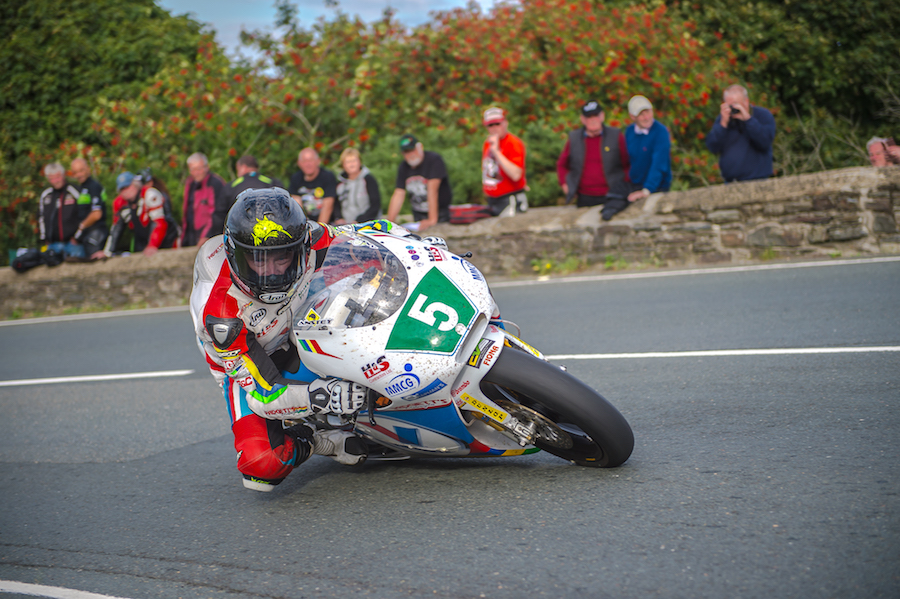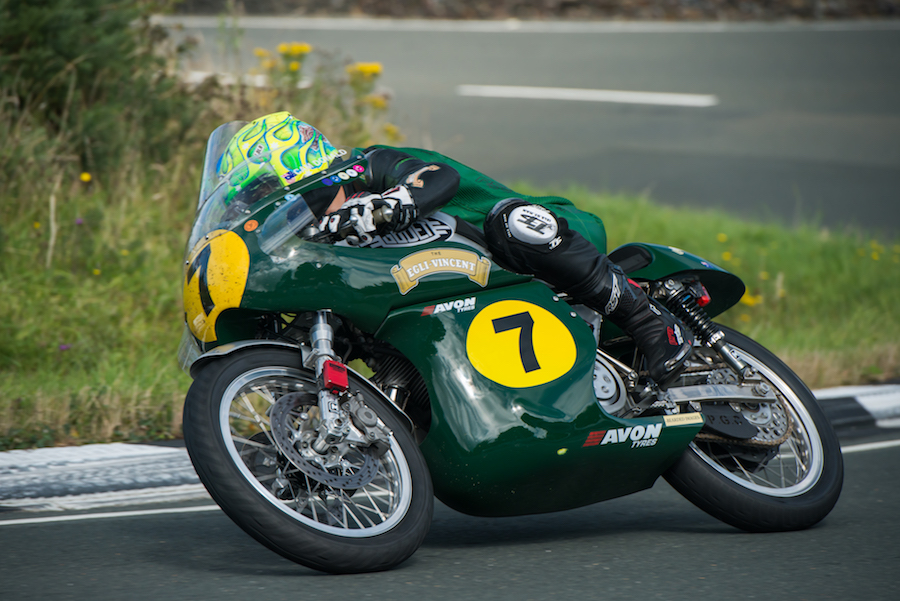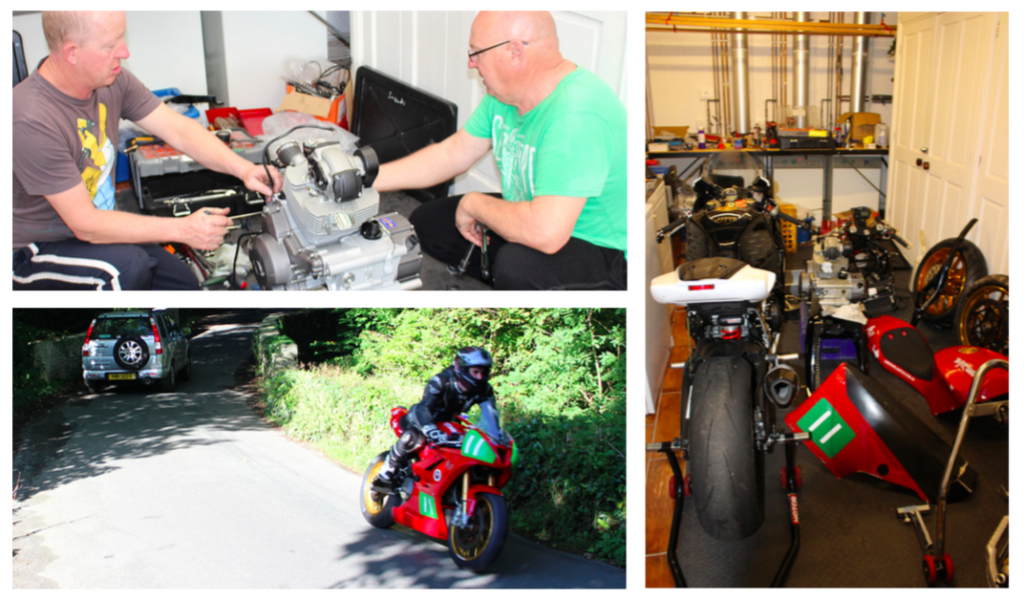This year’s Manx Classic TT and Manx Grand Prix were record breaking in good and bad ways
While June’s Isle of Man TT is the holy grail of ‘real roads’ racing, the combined Manx Classic TT and Manx Grand Prix in late August have created their own motorcycle niche. The Classic TT now has every road racing star, except Ian Hutchinson, competing on the world’s fastest vintage motorcycles. Meanwhile, the Manx GP is considered a feeder event for future TT stars.
This year controversy struck the Classic TT, while two Aussies took a big step up at the Manx GP.

Bruce Anstey
Bombshell at the Superbike Classic TT
In one of the most contentious endings to a day’s racing on the Isle of Man, four of the top six finishers were excluded from the official results of the Superbike Classic TT.
Michael Dunlop won, taking his Team Classic Suzuki XR69 to new lap and race records. He duelled with Dean Harrison to eventually prevail by 19.2 seconds and set a 126.808mph lap record. Third was James Hillier and the top three were all inside the lap record.
But a few hours later both the ZXR-750 Kawasakis of Harrison (Silicone Engineering) and Hillier (Greenall Racing) were disqualified by officials for having oversized engines. The teams supplying the ZXR-750s of fifth-place finisher Jamie Coward (Mistral Racing) and sixth-placed Horst Saiger (Greenall Racing) then withdrew their machines voluntarily. This promoted Team Winfield Suzuki XR69 rider Michael Rutter to second and William Dunlop (Herheim Racing Kawasaki) to third. William Dunlop’s ZXR-750 was examined and declared legal.
Superbike TT rules set a 1300cc limit for pre-1986 machines, such as the XR69, and 750cc for pre-1992 machines, such as the ZXR-750. These machines are similar to those seen each year at the AMCN Phillip Island International Challenge and this incident has huge implications for classic racing.
The Classic TT is booming in popularity and has attracted a 40 per cent increase in fans attending over the past four years. However, insiders have claimed some ZXR-750s have been punched out to 830cc and even had quickshifters fitted. Until now a competitor had to protest a rival to ensure eligibility.
James Hillier reacted by publicly quitting his Greenall Racing team, saying: “I was unaware of my bike being against the rule book. I took risks and tried my best for nothing.”
Observers were surprised at the speed of the leading Kawasakis this year. Hillier hit a blistering 175.7mph down Sulby Straight, faster even than Dunlop, while Harrison set a new 750cc record lap of 125.512mph, eclipsing Jim Moodie’s mark from 1999. That no longer stands after the controversy which tainted Dunlop’s moment of glory.
Early that day Dunlop had clawed his way back into contention in the Junior Classic TT on his 350cc MV triple after a fuel stop to beat Michael Rutter (Honda twin) with Alan Oversby (Honda) third. Cameron Donald was fourth, winning the Peter Williams Trophy for the highest-placed AJS or Matchless, while Maria Costello won the 250cc sub-class.

Aussie Alex Pickett won the privateer’s trophy in the Superbike race with a gutsy seventh place after battling through the field from 35th.
McPint’s dream win
For three years John McGuinness had tried to win the Senior Classic TT on Roger Winfield’s Paton twin. Three times he was stopped by mainly small issues. This year he won in record-breaking style, setting a new class lap record at 113.342mph and recording the first sub 20-minute circuit. He also smashed the existing race record by 57.5 seconds to set a new benchmark of 1hr 21min 10.189sec.
The race started as a split-second duel between McGuinness and Dean Harrison on a three-cylinder MV Agusta. Both riders lapped under the record from a standing start, but a refuelling stop for Harrison blunted his charge.
Maria Costello rode another Paton into third, claiming her first Classic TT podium, while history was made for the BSA marque when Philip McGurk set the first 100mph lap ever for a Gold Star (101.030mph).

Cam Donald won the Peter Williams trophy for highest placed AJS or Matchless
Anstey’s time warp
It was meant to be, perhaps. Kiwi Bruce Anstey had won the last 250cc race run in 2002, then started first on the road in the reintroduced Lightweight race. He went on to smash John McGuinness’s 1999 record by over 4 seconds with a 118.74mph second lap, which included slowing for fuel. On a Padgetts Honda RS250, Anstey led all the way to win by over a minute from Ian Lougher (Yamaha TZ) with Phil Harvey (Honda) third.

Paul Van Der Heiden
History made at the Manx GP
The Manx Grand Prix followed on from the Classic TT and Adelaide rider Paul Van Der Heiden soon rode into the history books as the first Aussie since Cameron Donald in 2008 (Superstock TT) to win on the TT course.
Riding a South Australian designed and built Ducati ‘650’ (see side story), the Moto Adelaide mechanic set a new race record in the Newcomers B Race. He finished 10 seconds ahead of Marc Ironside (Kawasaki), who set a new lap record of 111.101mph. Van Der Heiden’s best lap was 111.039mph and he showed consistent speed through the tricky parts of the course, keeping his cool as the race unfolded over four laps.
Jonathan Perry (Kawasaki) was narrowly outside record pace on the first lap, 11 seconds ahead of Van Der Heiden with Ironside 11 seconds behind. But a disastrous pit stop, when the fuse blew on his starter motor, lost Perry nearly three minutes. Van Der Heiden took the lead, skilfully maintaining a 10-second buffer on Ironside while Perry fought back to narrowly claim the final podium place.
Van Der Heiden’s Ducati started life as a $700 insurance write-off built up into a competitive racer with the help of Brian Rosser. More used to racing a BMW S1000RR, Van Der Heiden had to change his riding style for the lighter Ducati. It obviously worked.
Van Der Heiden then finished 11th in the SuperTwin race, two seconds ahead of Ironside. Perry finished fifth. Winner Jamie Hodson (Kawasaki) emulated his brother Rob, who took the victory last year.
South Australian Royce Rowe backed up his excellent debut at last year’s Manx Grand Prix with top-10 results in three classes.
He followed up his 10th placing in 2015 with a seventh in this year’s SuperTwin race on another Rosser Ducati sponsored by father Les Rowe. He was two places ahead of Nick Jefferies, who finished third last year.
Rowe also finished eighth in the Junior and sixth in the Senior races on a Suzuki GSX-R600. He bounced back from a practice crash that destroyed his SuperTwin Ducati (see side story) and left him badly bruised.
The Senior saw one of the Manx GP’s closest finishes, with Tom Weedon (Triumph) beating Andrew Dudgeon (Suzuki) by less than a second after four laps.
Royce Rowe’s father, Les, and brother, Leonard, were part his racing team, and after sharing the highs and lows Leonard gave an insight into what the two weeks mean to road racers. “The enjoyment shared between riders on the Isle of Man podium is something else,” he said. “It’s not just a win, it’s survival and genuine admiration for a fellow rider.”
Brian’s ‘super twin’
The achievements of the Brian Rosser designed-and-built 650cc Ducatis cannot be overstated. He took two ex-LAMS Ducati 659s, slightly destroked their engines and reconfigured the internals to produce 63kW (at the back wheel) at 11,000rpm with 60kW available from 9000rpm. Modifications to the original chassis brought weight down to just 145kg.
Rather than being fragile prototype racers, both Rosser’s Ducatis survived hundreds of kilometres in practice, qualifying and racing on the world’s most demanding circuit. What also is remarkable is that an air-cooled, two-valve-per-cylinder engine could even challenge the established SuperTwin class leaders, who are on liquid-cooled, four-valve-per-cylinder machines with years of tuning development. The two main bikes raced are Suzuki’s SFV650 V-twin and Kawasaki’s ER650 parallel twin. There is an extensive UK cottage industry catering to this popular class resulting in Moto2-like handling with horsepower well over 67kW.
First in the Newcomers B race and seventh and 11th in the SuperTwin race comes as no surprise to our Youngy, who tested Rosser’s ‘super twin’ (Vol 65 No 14) at Mac Park. He revealed that Rosser had created “a pure and purposeful racing machine” with a perfect power delivery for the Isle of Man circuit.

TOP LEFT Brian Rosser (right) and mechanic Locky start rebuilding the Ducati from the ground up ABOVE LEFT: A secret test of the rebuilt Ducati
ABOVE RIGHT Stripped Ducati with Royce’s Suzuki in the cramped B&B laundry turned into a workshop
The crash
Royce Rowe’s practice crash shows the big difference between road and circuit racing.
On track for a 110mph lap his shoulder brushed the hedge too early as he entered The Nook, at the 37th milestone. Realising he would exit far too wide, he leant the Ducati right over but tucked the front wheel into a lowside.
A circuit racer wouldn’t expect much damage crashing like this at around 110km/h, but there’s a vast difference in road racing.
Both the bike and Rowe slid into the gutter and cartwheeled through a picket fence. Rowe was taken to hospital with cuts and bruises. He was lucky. The Ducati’s frame was destroyed. Even the rear axle had snapped but the American-made forged Carrozzeria wheels were unscathed.
While Rowe went to hospital for checks, team supporters drove across the UK and back for a new frame. Brian Rosser and his small team quickly rebuilt the bike. Later they paid the landowner for fence repairs.
REPORT HAMISH COOPER PHOTOGRAPHY MATT COATES